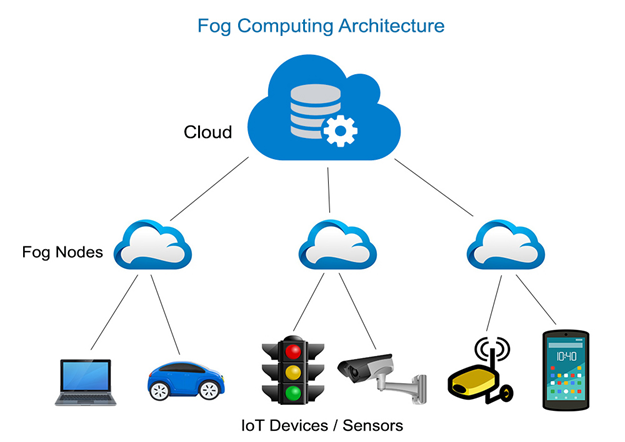Fog and Cloud have a close proximity in computing as in real world. In cloud computing, remote servers hosted on the internet use to store, manage and process data which sends from IoT devices or sensors. Data generated through these devices will send to the cloud over the internet, instead of store them in in-house storage devices. For instance, most of the smart device operations depend on the connectivity with cloud systems. All your contact details, images, documents, music will be transferred to the cloud as soon as they generated. Cloud computing has a great impact on both individuals and businesses. As a key benefit of cloud on businesses, it eliminates the in-house data storage and by that, it helps to decrease the storage and operational cost. Though the cloud computing provides comprehensive data management facilities to the businesses, it also has some major downsides as well. Since the cloud computing depends on the internet, it consists of downtime issues, security risks, data latency and bandwidth problems etc.
Fog computing emerged as a solution to the cloud related problems. Cisco’s, Product line manager, Ginny Nichols has originally coined the term fog computing. It also refers as edge computing or fogging. This term, fog, has a connection with the real world weather phenomenon, a cloud formed close to the ground. In fog computing, fog nodes are placed in a logical position between the cloud and the data source, more precisely closer to the data source.
The OpenFog Consortium is formed by a group of high tech companies and academic institutions including Cisco, Intel, Microsoft, Dell, ARM and Princeton University in 2015, to standardize the fog computing. It helps to gain the maximum benefits from Internet of Things.
How fog computing works
In fog environment, data generated by sensors, smart devices or IoT devices will transmit to the middle layer called fog nodes which placed closer to the data source. These fog nodes are capable of handling the operations that required less computing power and less storage. Therefore, no need to transmit every bit of data to cloud for processing, since, fog nodes are able to process that data more efficient manner and provide responses quicker than cloud. Data travel time is a very important factor when handling critical operations. For instance, in healthcare sector, data analysing should be done within very short period of time, because sometimes even few minutes delay could be critical to patient’s safety. Fog computing enables real-time analytics in healthcare sector in order to provide the fast and accurate treatment to patients. Still the cloud services can be used to manage and analyse large volume of data. Big data is often related with IoT technologies, since big data operations are required more computing power and data storage facilities, cloud is still a better option for operations such as big data management and big data mining. In fact, fog computing can be consider as an extension to the cloud computing.

Fog computing and Internet of Thing
Many research firms have predicted that, in future, billions of internet-enabled devices will be connected to the internet. Gartner, a research company forecast that, by 2020, more than 20 billion of IoT devices will be connected. More internet-enabled devices will result to generate more data than ever. Cisco, forecasts that, IoT devices will generate 600 zettabytes of data by 2020. It means in future, immense volume of data will transfer between the cloud and data sources and essentially, current network infrastructures cannot cope with that amount of data. It also a time consuming and costly process to transmit the large volume of data generated by IoT devices, to cloud data centres. Current cloud computing models may not encounter any bandwidth issues so far. But, in near future, with the expansion of IoT technologies, it will be a major problem where all organisations need to find solutions. In fog computing, data processing takes place closer to the edge devices, therefore IoT systems can eliminate many cloud computing related problems such as security risks, data latency and bandwidth issues etc.
Smart buildings, smart cities are some new concepts emerged with the invention of Internet of Things. In smart buildings, IoT devices install to streamline the building maintenance activities. Smart sensors can be used to automate the processes such as security entrance, car park operations, energy usage etc. With fog computing, data collects from IoT devices can be processed and analysed in fog nodes placed in building environment, rather than transmits to the cloud. Cities can be turn into smart cities with IoT technologies. Smart traffic light systems, smart grids, urban mobility, waste management systems can be identified as the key areas in smart cities and productivity and efficiency of these systems can be optimized by fog computing.
OpenFog consortium has revealed five technical reasons why the IoT needs fog computing.
- Function allocation
- Distributed architecture
- Immersive distribution
- SCALE capabilities (Security, Cognition, Agility, Latency and Efficiency)
- Latency
Benefits of Fog Computing
Since the data processes closer to the data source, this technology has some significant benefits over cloud computing. Many IoT platforms gain more advantages from fog computing than cloud.
- Minimal amount of data send to cloud.
- Save bandwidth
- Reduce data latency
- Improve data security
- Immediate processing of data

